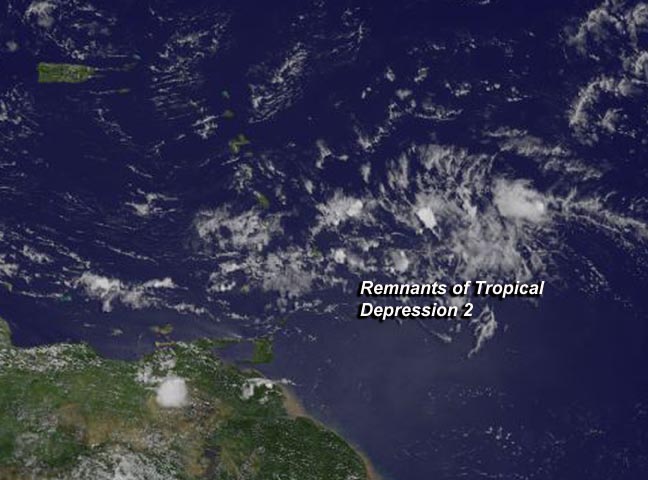Satellite Shows Atlantic Tropical Depression Degenerate

TD2 appeared as just a weak swirl of clouds with no strong thunderstorms or deep convection. Image Credit: NASA/NOAA GOES Project
At 1445 UTC (10:45 a.m. EDT), NOAA's GOES-East satellite captured an image of what was once Tropical Depression 2 (TD2), about 400 miles east of the Lesser Antilles.
The GOES-East visible satellite imagery indicated that the depression weakened since July 22. TD2 appeared as just a weak swirl of clouds with no strong thunderstorms or deep convection.
The GOES image was created by NASA/NOAA's GOES Project at NASA's Goddard Space Flight Center in Greenbelt, Maryland.
In addition, the NHC noted that low-level cloud motions showed no evidence of a closed surface circulation and declared TD2 a remnant low pressure area.
At 11 a.m. EDT (1500 UTC), the National Hurricane Center (NHC) issued their final advisory on TD2, and cited that it had degenerated into a tropical wave.
Despite that, the remnants of the depression are expected to move through the Lesser Antilles this evening (July 23) with some areas of gusty winds and showers, according to the NHC.
The last NHC advisory placed the center of the degenerated depression's center near 14.0 north latitude and 56.0 west longitude, about 365 miles (590 km) east-southeast of the Lesser Antilles.
It was moving quickly to the west at 25 mph (41 kph) and had maximum sustained winds near 35 mph (55 kph) what were quickly waning. TD2's minimum central pressure was near 1012 millibars.
Text credit: Rob Gutro
NASA's Goddard Space Flight Center
Media Contact
All latest news from the category: Earth Sciences
Earth Sciences (also referred to as Geosciences), which deals with basic issues surrounding our planet, plays a vital role in the area of energy and raw materials supply.
Earth Sciences comprises subjects such as geology, geography, geological informatics, paleontology, mineralogy, petrography, crystallography, geophysics, geodesy, glaciology, cartography, photogrammetry, meteorology and seismology, early-warning systems, earthquake research and polar research.
Newest articles

Trotting robots reveal emergence of animal gait transitions
A four-legged robot trained with machine learning by EPFL researchers has learned to avoid falls by spontaneously switching between walking, trotting, and pronking – a milestone for roboticists as well…

Innovation promises to prevent power pole-top fires
Engineers in Australia have found a new way to make power-pole insulators resistant to fire and electrical sparking, promising to prevent dangerous pole-top fires and reduce blackouts. Pole-top fires pose…

Possible alternative to antibiotics produced by bacteria
Antibacterial substance from staphylococci discovered with new mechanism of action against natural competitors. Many bacteria produce substances to gain an advantage over competitors in their highly competitive natural environment. Researchers…





















